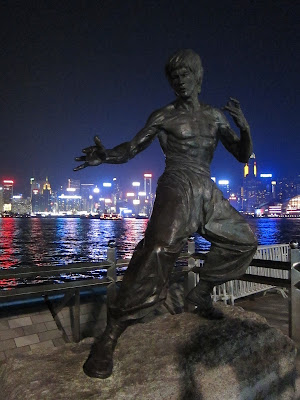Before the British colonization, Hong Kong was a land of farmers and fishermen. Its metamorphosis in the last two centuries is amazing. Hong Kong was placed under British occupation in 1841 as a result of the first opium war. But the British decided it was not enough and after other wars and negociations, in 1898, Hong Kong reached the territory it still covers today: a peninsula and 262 islands! The 99 years lease ended in 1997 and Hong Kong was given back to the Chinese.
And what was retroceded? From rocky island Hong Kong had become a modern metropolis, one of the world's leading international financial centres and most densely populated areas. In 1997 Hong Kong Special Administrative Region was formally establised with a certain degree of autonomy and its own government. This statute will remain untouched for the next fifty years.
View from Victoria Peak
Hong Kong and its forest of skyscrapers.. a world of wild capitalism and frenzied consumption. Every type of food or good is available. We nearly bumped into a shopping mall at every corner of every street. The network of public transportation (tram, bus, subway, ferry) is really neat and efficient and covers the whole territory.
Boat traffic in Hong Kong harbour is so intense that freighters are unload away from the shores by lighters. Those strange boats with a huge crane bustle about like little ants. They approach the freighters on both sides and start loading or unloading the containers in the middle of the bay.
But even in the highly modern Hong Kong we found some typical Chinese features:
Temple Street restaurants
Mail boxes
On a more glamorous side, the Avenue of Stars follows the Hollywood Walk of Fame example but the celebrities are all Chinese. From the dozens we walked on, here are the only two one we recognized! ;)
Statue of Bruce Lee
In the rush for development Hong Kong had to face a rugged territory with limited lowland. So territories were extended in stages, won over the sea. We found the map below very vivid:
Map in the absorbing Hong Kong History museum
Three-quarter of Hong Kong territory is still countryside. Half an hour away from the skyscrapers, wild areas and sandy beaches are all around, perfect places for leisure and tourism. Like in a small paradise, one can swim in warm waters, sail around desert islands or treck in rainforests.
This gives Hong Kong many advantages and allows a high quality of life for qualified foreigners. In fact we had the chance to be hosted by two very nice French expatriates who invited us in their busy daily lives. Another way to learn about a city and a lifestyle.
View from the Giant Buddha
On the top of Lantau island, near Po Lin Buddhist Temple, was erected a giant Buddha statue towering above from its thirty-four meters height the wonderful natural landscapes. A walk in the green vegetation took us to the Path of Wisdom: a forest of wood posts with Chinese inscriptions of them. A place for meditation.
Giant Buddha
Path of Wisdom
On this island we also visited a picturesque fishermen village, O Tai. Pedestrianized alleyways lead to unstable pile dwellings over the river. There fishes are still traditionally dried and salted. What a refreshing contrast with the blazing city life!
Dry fish
















No comments:
Post a Comment